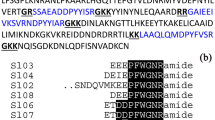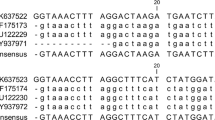Abstract
FEMALE mites of the species Pyemotes tritici inject an extremely potent venom into their insect prey that causes muscle-contraction and paralysis1–4. These mites are able to paralyse insects 150,000 times their size5 and their venom is effective in a broad range of insect species4. A toxin (TxP-I) associated with the mite venom apparatus causes immediate muscle-contractive paralysis when injected into insects but not mice6. In this report, we describe the cloning, sequencing and expression of a complementary DNA (Tox-34) encoding TxP-I. Insect cells infected with a recombinant baculovirus (vEV–Tox34) expressing Tox-34 secrete three polypep-tides related to TxP-I which cause paralysis on injection. Larvae infected with vEV–Tox34 become paralysed during infection, thus reflecting the potential application of this toxin gene in insect biocontrol methods. The toxin gene expression system will also allow further exploration of the neurophysiological basis of its insect-specific effects.
This is a preview of subscription content, access via your institution
Access options
Subscribe to this journal
Receive 51 print issues and online access
$199.00 per year
only $3.90 per issue
Buy this article
- Purchase on Springer Link
- Instant access to full article PDF
Prices may be subject to local taxes which are calculated during checkout
Similar content being viewed by others
References
Krczal, H. Acarina 1, 385–625 (1959).
Moser, J. C. Trans. R. Ent. Soc. London 127, 185–191 (1975).
Vaivanijkul, P. & Haramoto, F. H. Proc. Hawaii Ent. Soc. 20, 443–445 (1968).
Weiser, J. & Slama, K. Ann. Ent. Soc. Am. 57, 479–482 (1964).
Tomalski, M. D. et al. Toxicon 26, 127–132 (1988).
Tomalski, M. D. et al. Toxicon 27, 1151–1167 (1989).
Davis, L. G., Dibner, M. D. & Battey, J. F. Basic Methods in Molecular Biology (Elsevier, New York, 1986).
Tomalski, M. D., Wu, J. & Miller, L. K. Virology 167, 591–600 (1988).
Sanger, F., Nicklen, S. & Coulson, A. Proc. natn. Acad. Sci. U.S.A. 74, 5463–5467 (1977).
Miller, L. K. A. Rev. Microbiol. 42, 177–179 (1988).
Ooi, B. G., Rankin, C. & Miller, L. K. J. molec. Biol. 210, 721–736 (1989).
Miller, D. W., Safer, P. & Miller, L. K. in Genetic Engineering: Principles and Methods Vol. 8 (eds Setlow, J. & Hollaender, A.) 277–298 (Plenum, New York, 1986).
Wang, X., Ooi, B. G. & Miller, L. K. Gene 100, 131–137 (1991).
Miller, L. K., Lingg, A. J. & Bulla, L. A. Jr. Science 219, 715–721 (1983).
Carbonell, L. F. et al., Gene 73, 409–418 (1988).
Bishop, D. H. L. et al. in The Release of Genetically Engineered Micro-organisms (eds Sussman, M., Collins, C. H. Skinner, F. A. & Skinner, D. E.) 143–179 (Academic, New York, 1988).
Laemmli, U. K. Nature 277, 680–685 (1970).
Towbin, H., Staehelin, R. & Gordon, J. Proc. natn. Acad. Sci. U.S.A. 76, 4350–4354 (1979).
Blake, M. S. et al. Analyt. Biochem. 136, 175–179 (1984).
Author information
Authors and Affiliations
Rights and permissions
About this article
Cite this article
Tomalski, M., Miller, L. Insect paralysis by baculovirus-mediated expression of a mite neurotoxin gene. Nature 352, 82–85 (1991). https://doi.org/10.1038/352082a0
Received:
Accepted:
Issue Date:
DOI: https://doi.org/10.1038/352082a0
This article is cited by
-
Development of a recombinant baculovirus with dual effects to mediate V-ATPase interference by RNA in the fall armyworm Spodoptera frugiperda
Journal of Pest Science (2023)
-
A novel recombinant baculovirus overexpressing a Bacillus thuringiensis Cry1Ab toxin enhances insecticidal activity
Biological Procedures Online (2014)
-
Expression, renaturation and biological activity of recombinant conotoxin GeXIVAWT
Applied Microbiology and Biotechnology (2013)
Comments
By submitting a comment you agree to abide by our Terms and Community Guidelines. If you find something abusive or that does not comply with our terms or guidelines please flag it as inappropriate.



